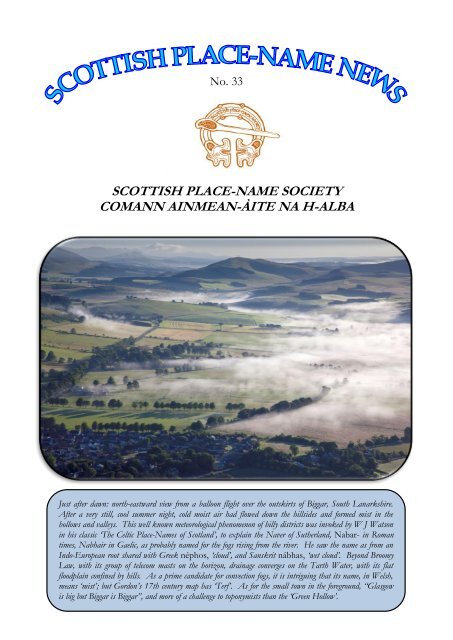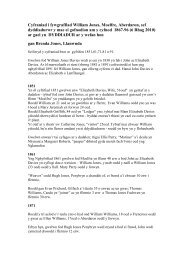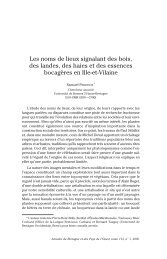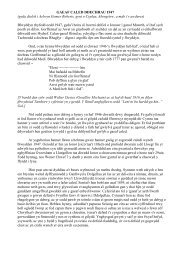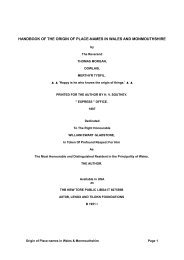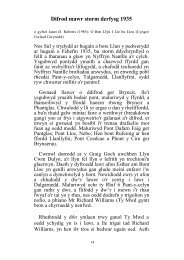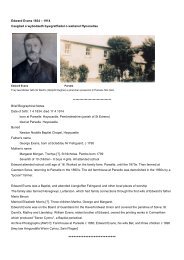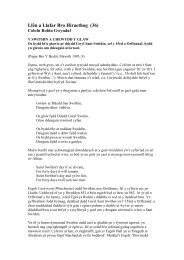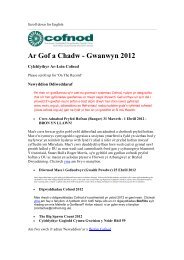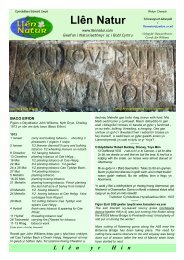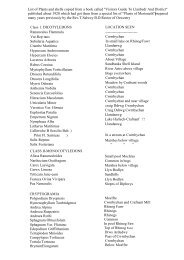new book: 'the place-names of bute'
new book: 'the place-names of bute'
new book: 'the place-names of bute'
You also want an ePaper? Increase the reach of your titles
YUMPU automatically turns print PDFs into web optimized ePapers that Google loves.
No. 33<br />
Autumn 2012<br />
The Newsletter <strong>of</strong> the<br />
SCOTTISH PLACE-NAME SOCIETY<br />
COMANN AINMEAN-ÀITE NA H-ALBA<br />
Just after dawn: north-eastward view from a balloon flight over the outskirts <strong>of</strong> Biggar, South Lanarkshire.<br />
After a very still, cool summer night, cold moist air had flowed down the hillsides and formed mist in the<br />
hollows and valleys. This well known meteorological phenomenon <strong>of</strong> hilly districts was invoked by W J Watson<br />
in his classic ‘The Celtic Place-Names <strong>of</strong> Scotland’, to explain the Naver <strong>of</strong> Sutherland, Nabar- in Roman<br />
times, Nabhair in Gaelic, as probably named for the fogs rising from the river. He saw the name as from an<br />
Indo-European root shared with Greek néphos, ‘cloud’, and Sanskrit nábhas, ‘wet cloud’. Beyond Broomy<br />
Law, with its group <strong>of</strong> telecom masts on the horizon, drainage converges on the Tarth Water, with its flat<br />
floodplain confined by hills. As a prime candidate for convection fogs, it is intriguing that its name, in Welsh,<br />
means ‘mist’; but Gordon’s 17th century map has ‘Terf’. As for the small town in the foreground, “Glasgow<br />
is big but Biggar is Biggar”, and more <strong>of</strong> a challenge to toponymists than the ‘Green Hollow’.
The postal address <strong>of</strong> the Scottish Place-<br />
Name Society is:<br />
c/o Celtic and Scottish Studies, University <strong>of</strong><br />
Edinburgh, 27 George Square, Edinburgh<br />
EH8 9LD<br />
Membership Details: Annual membership £6<br />
(£7 for overseas members because <strong>of</strong> higher<br />
postage costs), to be sent to Peter Drummond,<br />
Apt 8 Gartsherrie Academy, Academy Place,<br />
Coatbridge ML5 3AX.<br />
Scottish Place-Name Society web site:<br />
http://www.spns.org.uk/<br />
Newsletter Editor: Bill Patterson (e-mail<br />
pns.patterson3dr@btinternet.com)<br />
FROM THE AGM<br />
For those who were not able to be at the AGM<br />
in Oban, the Committee thought it would be<br />
useful to mention in print a few <strong>of</strong> the previous<br />
year’s more significant achievements.<br />
There is a rolling programme <strong>of</strong> publications,<br />
largely managed by Jake King. Early this year we<br />
issued in <strong>book</strong> form a collection <strong>of</strong> articles<br />
written over several decades by our Honorary<br />
President Pr<strong>of</strong> Bill Nicolaisen: In the Beginning was<br />
the Name. Thanks to successful fund-raising by<br />
Doreen Waugh, who has now retired from the<br />
Committee, not only has the cost <strong>of</strong> this<br />
substantial <strong>book</strong> been kept down to £10, but a<br />
student essay prize has been inaugurated in Pr<strong>of</strong><br />
Nicolaisen’s honour.<br />
In March to November 2011 the Society<br />
partnered Scottish Language Dictionaries, in the<br />
Scots Words and Place-Names project based at<br />
Glasgow University. This was aimed at finding<br />
out how modern social media could be used to<br />
broaden public interest in language and <strong>place</strong><strong>names</strong>.<br />
It included a very successful competition<br />
for schools, and used Face<strong>book</strong> and Twitter to<br />
engage with the public. An important result is<br />
the electronic Glossary <strong>of</strong> Scottish Place-Name<br />
Elements compiled by Alison Grant, online at<br />
http://www.gla.ac.uk/swap. Three members<br />
represented the Society in a public event at the<br />
Riverside Museum in Glasgow on 9 June, in<br />
connection with Michael Wood’s series <strong>of</strong><br />
programmes on British history for the BBC.<br />
The previous Convener, Simon Taylor, has been<br />
made an Honorary Fellow <strong>of</strong> the Royal Scottish<br />
Geographical Society, and our committee<br />
member Ellen Bramwell has gained her PhD for<br />
research on naming in Scottish communities.<br />
The Society continues to be grateful to Leslie<br />
and Elizabeth Fraser for running the conference<br />
<strong>book</strong>stalls, which support the Society both<br />
intellectually and financially.<br />
Our Treasurer, Peter Drummond, writes:<br />
“Readers not able to come to AGMs may like to<br />
know something about our finances. We have<br />
about 340 members, which generates some<br />
£1750 p.a., which approximately equals the cost<br />
<strong>of</strong> printing and posting the Newsletter. The<br />
conferences, whose accommodation and<br />
catering costs are usually around £1000 each, are<br />
paid for by conference fees. Our other sources<br />
<strong>of</strong> income include donations, Gift Aid on the<br />
subscriptions, our <strong>book</strong>stall sales and sales <strong>of</strong> the<br />
Society’s own publications. This is used for such<br />
things as <strong>new</strong> publications, and supporting<br />
students’ attendance at conferences. If any<br />
member would like a copy <strong>of</strong> the 2011-12<br />
accounts (held in an Excel file), contact the<br />
Treasurer at peter.drummond@btinternet.com.”<br />
MERKLANDS, PENNYLANDS<br />
AND DAVACHS IN ARGYLL<br />
The land-assessment systems <strong>of</strong> Scotland can be<br />
confusing. In documents and <strong>place</strong>-<strong>names</strong> we<br />
find a variety <strong>of</strong> terms such as merklands,<br />
pennylands, davachs, carucates, arachors,<br />
cowlands and mail-lands. How did each system<br />
articulate with the others – over space and time?<br />
Our approach shares much with the toponymist.<br />
We also derive evidence from documents and<br />
<strong>place</strong>-<strong>names</strong>. But the type <strong>of</strong> evidence we are<br />
working with gives us one crucial advantage. The<br />
systems we are studying were bound together by<br />
arithmetic. The relationships between their<br />
different parts were precisely defined – as were<br />
the relationships between different systems. We<br />
do not struggle with those nuances <strong>of</strong> meaning<br />
which can so trouble the textual or linguistic<br />
historian. If we can work out the various ratios<br />
within each system as well as the ratios between<br />
the various systems then we can reconstruct<br />
patterns even for those areas where the evidence<br />
is weak.<br />
In practice such matters are seldom crystal-clear.<br />
Why did the relationships between merklands<br />
and ouncelands vary? We have lost the<br />
understanding shown by this mid-fourteenth<br />
century scribe:<br />
2
sexaginta marcatis terre in partibus de Lochabre<br />
videlicet de decem et septem denariatis terre de Loche<br />
de dimidia davata terre de Kylmalde et de una<br />
davata cum dimidia de Locharkage<br />
(60 merklands in Lochaber viz. 17<br />
pennylands <strong>of</strong> Lochiel, half a davach <strong>of</strong><br />
Kilmallie and 1½ davachs <strong>of</strong> Loch Arkaig;<br />
RMS I (520)).<br />
The writer refers to three different landassessment<br />
systems but could happily translate<br />
between them – much as we can convert<br />
between different currencies today.<br />
This article is based on research into landassessment<br />
in the Hebrides and along the<br />
mainland west coast from Cowal to Glenelg.<br />
Historically this area has been recognised as<br />
having two main systems – merklands plus an<br />
earlier network <strong>of</strong> ouncelands and pennylands.<br />
Davachs have long been held to be absent from<br />
Argyll but there have been attempts to<br />
accommodate a system <strong>of</strong> ‘houses’ in the former<br />
Dalriada.<br />
Merklands, the youngest system, were based on<br />
the merk <strong>of</strong> 13s 4d or 160d. We assume they<br />
spread sometime after the 1130s when the Scots<br />
issued their first coins. They occur throughout<br />
the area under study but in many <strong>place</strong>s were<br />
simply a nominal overlay. Lewis had a merkland<br />
valuation but all the subdivisions were reckoned<br />
in pennylands. Place-name examples include<br />
Marganish (Arran - NS 0222) and<br />
Margmonagach (Kintyre NR 6735) < marg,<br />
merk. Confusingly, two documents refer to ‘old<br />
merks’ in Kintyre.<br />
Ouncelands and pennylands are the next system<br />
we meet. They link to each other in the ratio <strong>of</strong> 1<br />
ounceland to 20 pennylands (but 1:18 in the far<br />
north <strong>of</strong> Scotland). Pennylands are essentially a<br />
refinement <strong>of</strong> ouncelands and allow a more<br />
precise measure <strong>of</strong> fiscal responsibility.<br />
Ouncelands were such large areas <strong>of</strong> land that<br />
they do not <strong>of</strong>ten survive in <strong>place</strong>-<strong>names</strong><br />
(Ungnacille, Skye; Ungistaffard, Mull). Pennylands<br />
are common in <strong>place</strong>-<strong>names</strong> and there are<br />
also significant numbers <strong>of</strong> <strong>names</strong> referring to<br />
half-pennylands or farthinglands. These can<br />
occur anywhere between Rosneath and Lewis.<br />
Examples include Peinharsbreck (Trotternish,<br />
Skye c. NG 4063) < peighinn, penny;<br />
Levencorroch (Arran NS 0021) < leth-pheighinn,<br />
halfpenny; Feorlinbreck (Rosneath NS 2391) <<br />
feoirling, farthing<br />
Although ouncelands and pennylands were<br />
linked into one system they may have different<br />
points <strong>of</strong> origin. Ouncelands could be as early as<br />
the mid-ninth century. Pennylands probably date<br />
to after the introduction <strong>of</strong> the Hiberno-Norse<br />
coinage in Dublin c. 995 AD.<br />
In the past davachs were recognised in the<br />
northern part <strong>of</strong> our area but thought to be<br />
absent from Argyll. This is not so. There is some<br />
circumstantial toponymic evidence for their<br />
presence throughout Argyll and we have the<br />
name Dachnaachlysk which occurs in three<br />
documents dealing with Kintyre in 1502-6. This<br />
farm has since become Dalmore (NR 6910) but<br />
the first element was originally dach ‘davach’ and<br />
the last element was possibly a form <strong>of</strong> eccles (a<br />
Brittonic term indicating church-land). We also<br />
have a number <strong>of</strong> quarterland and eighthland<br />
<strong>place</strong>-<strong>names</strong> in the Southern Hebrides and South<br />
Argyll.<br />
In Kintyre the evidence suggests that a<br />
pennyland, a davach and an ‘old merk’ were the<br />
same and were worth 4 merks Old Extent. Place<br />
<strong>names</strong> such as Margnaheglish in Arran and Bute<br />
suggest ‘old merks’ or davachs were assigned to<br />
the church here too. Dachnaachlysk and<br />
Margnaheglish were functionally equivalent and<br />
represent a 1-davach church endowment.<br />
It seems likely that the system we find in<br />
Kintyre, Cowal and the Clyde islands obtained<br />
throughout Argyll. If we use the same ratios<br />
between pennylands and merklands we can<br />
project figures for davachs. This is important<br />
because there have been attempts to link landassessment<br />
data to early Dalriadic ‘houses’ and<br />
the levying figures found in the Senchus Fer<br />
nAlban.<br />
It appears as if the number <strong>of</strong> houses attributed<br />
to Cenél nGabráin in the Senchus matches very<br />
well with the number <strong>of</strong> davachs we can project<br />
for the territories they are likely to have held.<br />
Equally the total number <strong>of</strong> houses given in the<br />
Senchus is not much greater than the total<br />
number <strong>of</strong> davachs contained in the former<br />
Dalriada, (which may not have extended north<br />
<strong>of</strong> Appin).<br />
Apart from this there is little toponymic<br />
evidence for ‘houses’ in Argyll. Dr Bannerman<br />
gave four words for house in two versions <strong>of</strong> the<br />
Senchus: tech, treb, tellach and taighe/tighe. There<br />
are 819 farm-units with a land-assessment<br />
valuation in Lorn, Cowal, Kintyre and Islay.<br />
None <strong>of</strong> these have <strong>names</strong> derived from tech or<br />
tellach. There are 3 doubtful derivations from treb<br />
(Mulindry, Islay; Colintre & Muchtre, North<br />
3
Kintyre) but each is questionable and treb need<br />
not necessarily be a marker for Dalriadic Scots<br />
since we find it in other parts <strong>of</strong> Scotland<br />
associated with the Britons. We have only two<br />
early tigh <strong>names</strong> - Tydrum and Tycarmakan<br />
(Islay). It does not appear that Dalriadic ‘houses’<br />
were embedded deeply in Argyll but the survival<br />
<strong>of</strong> the equivalent native unit - the davach - may<br />
explain this.<br />
Denis Rixson (summarising his talk at the<br />
spring conference in Oban)<br />
ALEXANDER CARMICHAEL AND<br />
THE REV. NIEL CAMPBELL:<br />
TRACING TWO FOLKLORISTS’<br />
ENGAGEMENT WITH THE<br />
HIGHLAND ENVIRONMENT<br />
In my paper I investigated two major folklore<br />
collectors who laboured in the districts between<br />
Oban and Loch Awe – Glen Lonan, Muckairn,<br />
and Kilchrenan and Dalavich – at the end <strong>of</strong> the<br />
nineteenth century. One <strong>of</strong> them, Alexander<br />
Carmichael (1832–1912) is still recognised today<br />
thanks to his six-volume magnum opus full <strong>of</strong><br />
songs, stories, charms, blessings, prayers, and all<br />
manner <strong>of</strong> traditionary lore, Carmina Gadelica.<br />
Carmichael’s name, however, tends to be<br />
associated with the Outer Hebridean islands <strong>of</strong><br />
Uist and Barra where he worked as an exciseman<br />
for nearly two decades between 1864 and 1882.<br />
Much less well-known are Carmichael’s<br />
connections with Oban, where he passed two<br />
rather unsatisfactory years at the end <strong>of</strong> the<br />
1870s, and with Taynuilt, where he and his<br />
family spent their summer holidays after taking<br />
up residence in Edinburgh. Indeed, after finally<br />
completing the first two volumes <strong>of</strong> Carmina<br />
Gadelica in 1899, Carmichael and his wife Mary<br />
Frances left Edinburgh for Taynuilt, supposedly<br />
for good. They would spend only a few months<br />
there, however, before a falling out with the local<br />
factor meant that the couple had to return to the<br />
capital.<br />
The other collector is a much less familiar figure.<br />
Over a period <strong>of</strong> five years at the end <strong>of</strong> the<br />
nineteenth century the established minister <strong>of</strong><br />
Kilchrenan and Dalavich, the Rev Niel Campbell<br />
(1850–1904), would record hundreds <strong>of</strong> items<br />
from the people <strong>of</strong> his own and neighbouring<br />
parishes. He did so on behalf <strong>of</strong> the Edinburgh<br />
surgeon Robert Craig Maclagan (1839–1919),<br />
then supervising a major collecting project<br />
embracing the whole Highlands on behalf <strong>of</strong> the<br />
Folklore Society in London.<br />
The papers <strong>of</strong> both these collectors are<br />
preserved in the archives <strong>of</strong> the University <strong>of</strong><br />
Edinburgh. Carmichael’s form the kernel <strong>of</strong> the<br />
great Carmichael Watson Collection at the<br />
Centre for Research Collections at the University<br />
Library, while Campbell’s are to be found among<br />
thousands <strong>of</strong> other items in the Maclagan<br />
Manuscripts in the School <strong>of</strong> Scottish Studies<br />
Archives. Both are the subject <strong>of</strong> ongoing<br />
cataloguing projects, making research<br />
considerably easier.<br />
Carmichael’s hasty scribbles in his personal field<br />
note<strong>book</strong>s contrast nicely with Campbell’s<br />
beautifully written, highly idiosyncratic and<br />
playful letters to Maclagan. Both collectors<br />
devoted much <strong>of</strong> their labours to the stories<br />
local people told about conspicuous landmarks<br />
and antiquarian sites in their neighbourhood – or<br />
rather what they thought might be <strong>of</strong> interest to<br />
outsiders, and suitable to tell them. What we<br />
have, then, is generally what people regarded as<br />
traditional lore rather than modern anecdotes:<br />
fascinating in-depth insights into indigenous<br />
perceptions <strong>of</strong> the local historical landscape on<br />
the brink <strong>of</strong> the catastrophic cultural collapse <strong>of</strong><br />
the twentieth century. We have much historical<br />
information, such as from the ferryman at ‘New<br />
York’:-<br />
The ferry was originally between Inverinan<br />
and Fernoch. The cattle passed that way to<br />
the south. They tied one head by a rope to<br />
the boat. The rest <strong>of</strong> the herd were<br />
surrounded and easily got to follow. The<br />
cattle in this way swum the loch. The ferry<br />
was named ‘boidheach’ ‘beautiful’.<br />
[Maclagan MS 2739(3)]<br />
Local township nick<strong>names</strong> loom large, such as:-<br />
Cearcan-tomain Achanacraoibhe: Achna-cruive<br />
Partridges.<br />
Rabscallions Chillechreanain: Rapscallions <strong>of</strong><br />
Kilchrenan. These were regarded as the<br />
worst boys at the school, and these are<br />
school nick<strong>names</strong>… [Maclagan MSS 906(8)]<br />
Carmichael records that the people <strong>of</strong> Muckairn<br />
were known as Bearraich Mhuc Càrna, ‘the<br />
gibers <strong>of</strong> Muckairn’ because <strong>of</strong> ‘a bad reputation<br />
among their neighbours for their rude<br />
interference and impertinent remarks.’ [CW217<br />
fos.72–4]<br />
Much material is devoted to landmarks<br />
connected with death: green swards, supposedly<br />
scenes <strong>of</strong> murder past, or prominent trees (rarer<br />
then than now) as sites <strong>of</strong> hangings. Elaborate<br />
4
stories are recorded concerning hauntings and<br />
other supernatural phenomena, <strong>of</strong>ten connected<br />
with prominent buildings such as Lochnell<br />
Castle, Inverawe House, or Barbreck Farm. A<br />
whole complex <strong>of</strong> <strong>place</strong>-<strong>names</strong> in Glen Lonan –<br />
‘farms, streams, rocks, and wells’ – illustrated the<br />
Fenian lay <strong>of</strong> the death <strong>of</strong> the hero Diarmid,<br />
mythical ancestor <strong>of</strong> the Campbells. Such stories<br />
must have been considerably embellished for the<br />
Ossian-obsessed tourists who thronged Oban<br />
from the end <strong>of</strong> the eighteenth century. Other<br />
topographical items concern buried treasure with<br />
their associated markers, historical clan legends,<br />
and some anecdotes <strong>of</strong> more recent provenance,<br />
including reminiscences <strong>of</strong> ‘beating the bounds’.<br />
Far from being set in a timeless landscape, many<br />
items relate to recent changes and<br />
transformations. Landmarks such as Bonawe<br />
Furnace, and its associated industry, are said to<br />
have been foretold by local prophets. Some<br />
English <strong>names</strong> have re<strong>place</strong>d Gaelic:-<br />
Opposite Port innisherrich on Loch Awe is<br />
‘New York’ and between Taynuilt and<br />
Achnacloich is Australia. Then we have<br />
‘Nelson’s Monument’ at Taynuilt all<br />
evidently the fancies <strong>of</strong> the Smelting English<br />
Company or <strong>of</strong> Southern tourists who could<br />
not find it convenient to call them by their<br />
Gaelic <strong>names</strong> or as in the case <strong>of</strong> the<br />
Monument wished to attach a worthier<br />
tradition. [Maclagan MS 1772(1)]<br />
Some landmarks have even been recreated for<br />
tourists, such as a fake cairn illustrating a<br />
historical legend:-<br />
I fancy it has been built for the benefit <strong>of</strong><br />
tourists or rather <strong>of</strong> those who pr<strong>of</strong>it by<br />
their coming here. I cannot say whether it is<br />
the same as the funeral cairn I think not.<br />
One is not sorry that it is used for road<br />
‘metal’.<br />
… In any case a visit to the real cairn a<br />
scene <strong>of</strong> the tragedy takes the pedestrian 10<br />
minutes <strong>of</strong>[f] the road: keeps him i.e. 10<br />
minutes behind or adds ¾ <strong>of</strong> a mile to his<br />
journey. [Maclagan MS 1089]<br />
The topographical collections <strong>of</strong> Alexander<br />
Carmichael and the Rev. Niel Campbell are not<br />
just absorbing in themselves, but bear witness to<br />
the complexity, creativity, flexibility,<br />
disruptiveness, and mutability <strong>of</strong> naming<br />
practices and <strong>of</strong> engagement with <strong>place</strong>s even in<br />
one relatively small district <strong>of</strong> the Gàidhealtachd.<br />
It may be too easy to draw a contrast between<br />
the first ‘pure’ namers <strong>of</strong> a <strong>place</strong>, and ensuing<br />
generations who mispronounce and misinterpret<br />
at will. One tentative conclusion here might be<br />
that the distinction does not always hold, that<br />
people’s relations with their environment,<br />
especially with the conspicuous, the curious, and<br />
the unusual within it, are <strong>of</strong>ten far from<br />
straightforward.<br />
My thanks to Kirsty M Stewart and Guinevere Barlow,<br />
my colleagues at the Carmichael Watson Project, funded<br />
by a generous grant from the Leverhulme Trust. Thanks<br />
also to Caroline Milligan and Cathlin Macaulay for<br />
access to the draft catalogue for the Maclagan MSS.<br />
Domhnall Uilleam Stiùbhart, Carmichael<br />
Watson Project, University <strong>of</strong> Edinburgh<br />
SCOTTISH TOPONYMY IN<br />
TRANSITION: PROGRESSING<br />
COUNTY SURVEYS OF THE<br />
PLACE-NAMES OF SCOTLAND<br />
Scottish Toponymy in Transition (STIT) is an<br />
AHRC-funded research project at the University<br />
<strong>of</strong> Glasgow, running from May 2011 to June<br />
2014. The aim is to advance the long-term goal<br />
<strong>of</strong> surveying all <strong>of</strong> Scotland’s <strong>place</strong>-<strong>names</strong>, by<br />
publishing survey volumes for three historical<br />
counties and initiating research on two others.<br />
STIT continues the momentum <strong>of</strong> Simon<br />
Taylor’s The Place-Names <strong>of</strong> Fife, produced during<br />
the course <strong>of</strong> a previous AHRC-funded project<br />
(Gaelic in Medieval Scotland: The Onomastic Evidence,<br />
2006–2010), and aims to establish a firm<br />
foundation for future surveys. The team<br />
comprises Thomas Clancy (Principal<br />
Investigator), Carole Hough (Co-Investigator),<br />
Simon Taylor (Chief Researcher), Peter<br />
McNiven (Research Associate) and Eila<br />
Williamson (Research Associate). There is also a<br />
PhD student, Leonie Dunlop, whose role is vital<br />
not only in contributing to the research itself,<br />
but in ensuring that the project does indeed lay a<br />
foundation for the future by bringing <strong>new</strong> young<br />
scholars into the discipline.<br />
The project will produce two full county surveys,<br />
for the historical counties <strong>of</strong> Clackmannanshire<br />
and Kinross-shire. Both are small in terms <strong>of</strong><br />
geographical area, but have complex<br />
administrative and parish histories. These<br />
surveys will include a full toponymic analysis <strong>of</strong><br />
all <strong>place</strong>-<strong>names</strong> on the Ordnance Survey<br />
1:25,000 (Explorer) maps, and <strong>of</strong> all obsolete<br />
settlement <strong>names</strong> recorded before 1560. The<br />
research methods are those developed for The<br />
Place-Names <strong>of</strong> Fife, and the volumes will be<br />
produced to the same high standard.<br />
5
During the first year <strong>of</strong> the project, work on<br />
Kinross-shire has reached an advanced stage,<br />
with name collection and analysis completed for<br />
four <strong>of</strong> the five parishes (Cleish, Kinross, Orwell<br />
and Portmoak). Fossoway too is in draft, but<br />
remains to be finished. Alongside this,<br />
preliminary work has been carried out on<br />
Clackmannanshire, including the laying out <strong>of</strong><br />
head-<strong>names</strong> and grid references, collection <strong>of</strong><br />
data from early printed sources, and<br />
transcription <strong>of</strong> Ordnance Survey Name Book<br />
entries. The Name Books are among our key<br />
sources, and we are working with the National<br />
Records <strong>of</strong> Scotland to make them available for<br />
both toponymic and genealogical research.<br />
The other three counties will not be fully<br />
surveyed during the course <strong>of</strong> the project, but<br />
will be progressed to different stages. Building<br />
on his PhD thesis on the Gaelic settlement<strong>names</strong><br />
<strong>of</strong> Menteith (now under Stirling Council,<br />
but historically part <strong>of</strong> Perthshire), Peter<br />
McNiven will complete a survey <strong>of</strong> Menteith,<br />
intended as the first step towards a survey <strong>of</strong> the<br />
whole <strong>of</strong> Perthshire. Research on Cunninghame<br />
initiated by Thomas Clancy will similarly point<br />
ahead to a future survey <strong>of</strong> Ayrshire. Leonie<br />
Dunlop has begun work on north-east<br />
Berwickshire, focusing particularly on the<br />
charters <strong>of</strong> Coldingham preserved in Durham<br />
cathedral. Her PhD thesis has the working title<br />
“Breaking old and <strong>new</strong> ground: an analysis <strong>of</strong><br />
Anglo-Saxon lexis in the assertion and<br />
redistribution <strong>of</strong> land in four Berwickshire<br />
parishes”. The parishes in question are Abbey St<br />
Bathans, Bunkle and Preston, Cockburnspath<br />
and Coldingham, providing a mix <strong>of</strong> coastal and<br />
inland <strong>names</strong>. In another part <strong>of</strong> the same<br />
county, Carole Hough and Eila Williamson are<br />
undertaking a pilot study <strong>of</strong> four parishes along<br />
the border with England: Coldstream, Hutton,<br />
Ladykirk and Mordington.<br />
So much for the toponymy; what about the<br />
transition? Each <strong>of</strong> the study areas presents a<br />
different mix <strong>of</strong> linguistic strata, alongside<br />
transition <strong>of</strong> various kinds. In Clackmannanshire<br />
and Kinross-shire, the early Brittonic language is<br />
generally taken to move from British to Pictish<br />
(a view that may be challenged by the current<br />
research), and there is also transition between<br />
areas where Gaelic survived as a living language<br />
later than in others. In Menteith, Peter McNiven<br />
has identified the late fifteenth century as the<br />
transitional period when Gaelic began to be<br />
superseded by Scots for naming purposes. The<br />
toponymy <strong>of</strong> Cunninghame is predominantly<br />
Scots, but here too there is a Gaelic core, as well<br />
as <strong>names</strong> from British, Old English and Old<br />
Norse.<br />
Berwickshire reflects yet another type <strong>of</strong><br />
transition. Bordering on northern England and<br />
historically forming part <strong>of</strong> Anglo-Saxon<br />
Northumbria, its <strong>place</strong>-<strong>names</strong> have more in<br />
common linguistically with those <strong>of</strong> England<br />
than with those <strong>of</strong> other parts <strong>of</strong> Scotland.<br />
However, since the English Place-Name Survey<br />
(EPNS) stops short at the present-day border<br />
with Scotland, traditional scholarship has treated<br />
the border counties with the Scottish rather than<br />
the English onomasticon. Recent years have<br />
seen a paradigm shift towards treating the<br />
toponymicon <strong>of</strong> southern Scotland and northern<br />
England as a continuum (see e.g. Hough 2003,<br />
2009; Scott 2004, 2008), and now that the survey<br />
for County Durham is in progress, and Diana<br />
Whaley has been appointed as EPNS editor for<br />
Northumberland, there is a real opportunity for<br />
comparative analysis and collaboration. With<br />
<strong>names</strong> from Old English as well as from<br />
Cumbrian and Gaelic, Berwickshire raises<br />
questions not only about the diachronic<br />
transition from Old English to Older Scots, but<br />
also about the synchronic transition from Middle<br />
English to Middle Scots, and from Modern<br />
English to Modern Scots.<br />
It will be clear from the above that STIT is an<br />
exciting and challenging project requiring a wide<br />
range <strong>of</strong> expertise. We are most grateful for the<br />
active involvement and support <strong>of</strong> our Academic<br />
Advisory Board, comprising Dauvit Broun<br />
(University <strong>of</strong> Glasgow), Peder Gammelt<strong>of</strong>t<br />
(University <strong>of</strong> Copenhagen), Kay Muhr (Ulster<br />
Place-Name Society, Belfast), Kevin Murray<br />
(University College, Cork) and David Parsons<br />
(Centre for Advanced Welsh and Celtic Studies,<br />
Aberystwyth). We are also fortunate to be able<br />
to draw on our Knowledge Exchange Liaison<br />
Group (KELG), comprising two members <strong>of</strong><br />
the Academic Advisory Board (Dauvit Broun<br />
and Kay Muhr) alongside others based within<br />
the study areas themselves. They are Janet<br />
Carolan (Dollar Museum), Rob Close (Ayrshire<br />
Federation <strong>of</strong> Historical Societies), Mark Hall<br />
(Perth Museums and Art Gallery), Susan Mills<br />
(Clackmannanshire Council Museums and<br />
Heritage Service), David Munro (Kinross<br />
Museum) and David Strachan (Perth & Kinross<br />
Heritage Trust).<br />
Knowledge Exchange is, indeed, a key aspect <strong>of</strong><br />
the project. In order to progress the academic<br />
research, it is crucial to have input from local<br />
6
informants. And in order to disseminate that<br />
research, it is equally crucial to establish and to<br />
maintain links with local history societies,<br />
museums and other interested parties. We have a<br />
strong commitment to activities such as<br />
exhibitions, seminars and talks to local<br />
organisations, and we are in contact with –<br />
amongst others – Education Scotland, the Living<br />
Lomonds Landscape Partnership and the Ochils<br />
Landscape Partnership. Events that SPNS<br />
members were invited to attend included the<br />
BBC’s Great British Story roadshow in Glasgow<br />
on Saturday 9 June, where both STIT and SPNS<br />
were represented, and a <strong>place</strong>-name walk from<br />
Tillicoultry to Alva on Tuesday 19 June and<br />
Saturday 23 June organised by STIT as part <strong>of</strong><br />
the Ochils Festival.<br />
Further information on the project is available<br />
at:<br />
http://www.gla.ac.uk/departments/celtic/projects/stit.<br />
(Based on the talk given by Carole Hough,<br />
University <strong>of</strong> Glasgow, at the Oban Conference)<br />
References<br />
Hough, Carole (2003), ‘Larkhall in Lanarkshire<br />
and related <strong>place</strong>-<strong>names</strong>’, Notes and Queries 50, 1–<br />
3.<br />
Hough, Carole (2009), ‘“Find the lady”: the term<br />
lady in English and Scottish <strong>place</strong>-<strong>names</strong>’, in<br />
Names in Multi-Lingual, Multi-Cultural and Multi-<br />
Ethnic Contact: Proceedings <strong>of</strong> the 23rd International<br />
Congress <strong>of</strong> Onomastic Sciences, August 17–22, 2008,<br />
York University, Toronto, Canada, ed. Wolfgang<br />
Ahrens, Sheila Embleton and André Lapierre<br />
with the assistance <strong>of</strong> Grant Smith and Maria<br />
Figueredo (Toronto: York University), 511–18.<br />
McNiven, Peter Edward (2011), Gaelic Place-<br />
Names and the Social History <strong>of</strong> Gaelic Speakers in<br />
Medieval Menteith. PhD thesis, University <strong>of</strong><br />
Glasgow.<br />
Scott, Margaret (2004), ‘Uses <strong>of</strong> Scottish <strong>place</strong><strong>names</strong><br />
as evidence in historical dictionaries’, in<br />
New Perspectives on English Historical Linguistics:<br />
Selected Papers from 12 ICEHL, Glasgow, 21–26<br />
August 2002 Vol. 2: Lexis and Transmission, ed.<br />
Christian J. Kay, Carole Hough and Irené<br />
Wotherspoon (Amsterdam and Philadelphia:<br />
John Benjamins), 213–24.<br />
Scott, Maggie (2008), ‘Unsung etymologies:<br />
lexical and onomastic evidence for the influence<br />
<strong>of</strong> Scots on English’, in Yesterday’s Words:<br />
Contemporary, Current and Future Lexicography, ed.<br />
Marijke Mooijaart and Marijke van der Wal<br />
(Newcastle: Cambridge Scholars), 187–98.<br />
Taylor, Simon, with Gilbert Márkus (2006– ),<br />
The Place-Names <strong>of</strong> Fife, 4 vols <strong>of</strong> 5 so far<br />
published (Donington: Shaun Tyas).<br />
Watts, Victor (2007), The Place-Names <strong>of</strong> County<br />
Durham Part One. Stockton Ward, EPNS 83<br />
(Nottingham: English Place-Name Society).<br />
SCOTS PLACE NAMES<br />
The recent appearance in many parts <strong>of</strong> Scotland<br />
<strong>of</strong> Gaelic <strong>place</strong>-<strong>names</strong> at <strong>place</strong>s like railway<br />
stations has given rise to questions about the<br />
extent to which the multi-lingual nature <strong>of</strong> the<br />
country should be represented in the linguistic<br />
landscape.<br />
Last year signs appeared at Linlithgow railway<br />
station in West Lothian informing travellers that<br />
the Gaelic name for the town is Gleann Iucha.<br />
Any decision to provide multi-lingual signage is<br />
informed by a number <strong>of</strong> linguistic, political and<br />
social arguments. What is such a sign for? Is its<br />
purpose to achieve some (specific or nonspecific)<br />
linguistic outcome, for example, more<br />
people using Gaelic <strong>names</strong>. Or is it political –<br />
the intention perhaps to underscore the<br />
linguistically diverse nature <strong>of</strong> the community<br />
and therefore to encourage respect for<br />
difference. One <strong>of</strong> the issues with the policy <strong>of</strong><br />
providing Gaelic <strong>place</strong> <strong>names</strong> in areas where few<br />
people speak or use the languages is that at<br />
present there have been few if any attempts to<br />
explain what they’re for.<br />
But there are other questions which are rarely if<br />
ever addressed. These are connected to the other<br />
<strong>names</strong> a <strong>place</strong> may have and the manner in<br />
which these <strong>names</strong> are or are not recognised. In<br />
the case <strong>of</strong> Linlithgow there is a well-established<br />
and widely used name for the town, Lithgae,<br />
which is not recognised in the <strong>new</strong> signage but<br />
which is much more prevalent in the local<br />
community than the Gaelic name. And which it<br />
might be argued has far greater linguistic,<br />
cultural and historical significance to the people<br />
living locally. Lithgae is the name used by Scots<br />
speakers not only in Linlithgow itself but in the<br />
surrounding county and furth <strong>of</strong> it forbye so<br />
what is it <strong>of</strong> the three <strong>names</strong> for the town which<br />
makes it uniquely unacceptable for use in public<br />
space? (Actually, it can be seen in the town but<br />
only on the sign for the Lithgae Arms, a pub on<br />
the High Street.)<br />
The introduction <strong>of</strong> Gaelic signage requires us to<br />
ask questions about the status and visibility <strong>of</strong><br />
Scots <strong>place</strong> <strong>names</strong>. When we start to ask these<br />
questions we find ourselves considering the<br />
7
processes by which <strong>names</strong> have changed and in<br />
particular how Scots <strong>names</strong> have become not so<br />
much Anglicised as ‘primped’. Not so far from<br />
Linlithgow you can see a sign for Paddockhall<br />
cattery. As you drive past you can see the haugh<br />
and I guess if you were walking you might catch<br />
a glimpse <strong>of</strong> a puddock. But how should we<br />
respond to these historic changes, indicative as<br />
they are, after all, <strong>of</strong> a process by which language<br />
was deliberately changed, where the impact was<br />
not only on the name itself but the vocabulary,<br />
the breadth and depth <strong>of</strong> the lexical items<br />
available to speakers?<br />
In a series <strong>of</strong> articles and essays the Scots<br />
Language Centre has asked academics and<br />
commentators to consider some <strong>of</strong> these issues.<br />
You can read them and, if you like, join in the<br />
debate by visiting the Centre’s web site at<br />
www.scotslanguage.com. You’ll find the <strong>place</strong><br />
name feature on our home page. Folk with an<br />
interest in Scots in the linguistic landscape might<br />
also want to visit our collection <strong>of</strong> images on<br />
flickr. Gathered over five years the collection is a<br />
unique record <strong>of</strong> Scots in public space, some<br />
<strong>of</strong>ficial but mostly ‘community generated’.<br />
I’m hopeful that this fascinating subject<br />
continues to be a matter for discussion by SPNS.<br />
Is action needed, how should we respond to<br />
contemporary and historical <strong>place</strong> name<br />
questions? It would be interesting to have<br />
members’ views.<br />
Michael Hance, Director, Scots Language<br />
Centre<br />
A BERWICKSHIRE PUZZLE<br />
Though English <strong>of</strong> widely separated periods and,<br />
in between those, Scots, have had by far the<br />
greatest influence on the naming <strong>of</strong> <strong>place</strong>s in the<br />
most easterly Border county, there are also<br />
contributions from Gaelic and Northern<br />
Brittonic. Even Norse has a tiny look-in. So it<br />
should not be imagined that everything is simple<br />
in the study <strong>of</strong> Berwickshire <strong>place</strong>-<strong>names</strong>. Just<br />
over the Border from the Liberties <strong>of</strong> Berwick,<br />
on a lane parallel to the main road through<br />
Foulden, is an attractive small group <strong>of</strong><br />
buildings.<br />
It is now signed and <strong>of</strong>ficially known as<br />
Kirkbanny Farm, though in a recent Ordnance<br />
Survey map it has also appeared, in apparently<br />
more Gaelic guise, as Kilbanny. This happens to<br />
be the name <strong>of</strong> a small <strong>place</strong> in Co Waterford,<br />
Ireland, but whether that coincidence or<br />
antiquarianism has had some influence on the<br />
Kil- form can only be guessed at. On many<br />
editions and scales <strong>of</strong> OS maps the present<br />
Kirkbanny Farm was called ‘New Farm’ for over<br />
a century, but right at the beginning <strong>of</strong> the<br />
Ordnance Survey it appears on the 25 inches and<br />
6 inches to 1 mile maps, surveyed in 1857, as<br />
Kirkbannock.<br />
First Edition 25 inches to 1 mile map, surveyed 1857.<br />
(Thanks to NLS online map library.)<br />
So there is no helpful pattern or continuity, even<br />
less when we consider that on the Greenwood/<br />
Fowler/ Sharp map <strong>of</strong> Berwickshire, published<br />
in 1826 well before Kirkbannock appeared, it is<br />
‘New Farm’ just as it was later.<br />
The Ainslie (1775), Blackadder (1797) and<br />
Thomson (1821) maps do not show the <strong>place</strong> at<br />
all. However, Kirkbannock may not have leaped<br />
onto the map out <strong>of</strong> nowhere. In the right<br />
position in relation to Nunlands, on the<br />
Armstrongs’ map <strong>of</strong> 1771 is ‘Carbana’.<br />
Andrew & Mostyn Armstrong, Map <strong>of</strong> the County <strong>of</strong><br />
Berwick. (Thanks to NLS online map library).<br />
8
This can scarcely not be another guise <strong>of</strong> the<br />
name now in use. Its neighbour to the east is<br />
Nunlands, invariably so on maps since Gordon’s<br />
manuscript map <strong>of</strong> the Merche, drawn about<br />
1636-52, and the Blaeu map <strong>of</strong> 1654 likewise<br />
based on Pont’s work at the end <strong>of</strong> the 16th<br />
century, so an ecclesiastical association would<br />
not be too surprising. That is enough to prompt<br />
the thought that, given such local associations,<br />
the earlier and half-forgotten Carbana might<br />
have been reinterpreted as a kirk name, as<br />
happened with Kirkbuddo in Angus (Kirbuddo<br />
1533). But unlike at Kirkbuddo, there is no hint<br />
<strong>of</strong> a local *cair, a fortification or an enclosed<br />
homestead.<br />
Kirkbanny appears in James B Johnston’s The<br />
Place-Names <strong>of</strong> Berwickshire (1940), now more<br />
highly regarded for its listing <strong>of</strong> sources than for<br />
its etymologies. It is easy to understand why<br />
that might be, from his comment about<br />
Kirkbanny: “… other name for Foulden New<br />
Mains. Who Banny was is very uncertain. Baine<br />
was a daughter <strong>of</strong> the King <strong>of</strong> Alban in The Four<br />
Masters, and Béinne is an old British name.”; odd<br />
that he thinks <strong>of</strong> ancient personal <strong>names</strong> but not<br />
<strong>of</strong> Old Gaelic bennacht, now beannachd (from<br />
Latin benedictio) ‘blessing’, known to occur in<br />
many <strong>place</strong>-<strong>names</strong> elsewhere. However, this is<br />
enough to show that a resemblance to the name<br />
was not in his mind when he <strong>of</strong>fered a possible<br />
location for “BANNACHARVIK, ? Foulden: sic<br />
1637 Ret[ours]. Gael. beannach ‘horned <strong>place</strong>’, one<br />
where waters divide, cf. Loch Vennachar; and<br />
prob. airbheach, ‘ribbed, furrowed’”, a description<br />
which would plainly not match anywhere in<br />
Foulden parish; though anyone looking for a<br />
‘horn’ <strong>of</strong> land not far from Foulden would find a<br />
splendid one between the Tweed and the<br />
Whiteadder at their confluence just above<br />
Berwick 1 .<br />
We might now divide the name as Old Gaelic<br />
bennchar plus a suffix, rather than as Johnston<br />
did. If the reflexes <strong>of</strong> bennchar, ‘horn-cast’ 2<br />
usually refer to topography (pointed hills in<br />
Ireland, pointed bits <strong>of</strong> land or water in<br />
Scotland), the picture is complicated by the<br />
saintly-named Banchory Devenick and Banchory<br />
Ternan in Kincardineshire, and Beannchar<br />
(Bangor) over the Sheugh in County Down<br />
where St Comgall founded a monastery in the<br />
mid 6th century. It stretches coincidence<br />
somewhat if there is no etymological connection<br />
<strong>of</strong> the <strong>place</strong>s in the former Pictland with the<br />
Welsh and Breton Bangors, where early<br />
monasteries were named for their bangor, 3 a<br />
wattle enclosure around the precinct.<br />
It hardly needs to be said that to get from<br />
Bannacharvik in 1633 to Carbana in 1771 to<br />
Kirkbannock in 1857 would involve radical<br />
modifications: so radical in the first stage that it<br />
might be more credible to think <strong>of</strong> a repertoire<br />
<strong>of</strong> alternative vernacular forms (as for nearby<br />
Auchencraw/ Edencraw – representing achadh<br />
and alltan? – which have coexisted for<br />
centuries), only intermittently and erratically<br />
making it into written record. Although the<br />
probability that Kirkbanny began as an<br />
ecclesiastical settlement must be slight indeed,<br />
there is always the hope that research in obscure<br />
medieval documents, or field <strong>names</strong>, might cast<br />
some light. (WP)<br />
1 Horncliffe (Hornecliff 1210) is upstream <strong>of</strong> the<br />
confluence, on the Northumberland bank <strong>of</strong> the<br />
Tweed, but it is more likely to refer to some more<br />
local feature.<br />
2 See W J Watson The Celtic Place-Names <strong>of</strong> Scotland,<br />
480-481, on bennchar/ beannchar as a topographical<br />
term.<br />
3 See discussion <strong>of</strong> Bangor <strong>names</strong> in Dictionary <strong>of</strong> the<br />
Place-Names <strong>of</strong> Wales, H Wyn Owen and R Morgan;<br />
they note that Old English burg was suffixed to the<br />
name <strong>of</strong> Bangor[-is-Coed], e.g. Bonkerbury 1278-81.<br />
SKIVO ~ SKYFOG<br />
SKIVO Midcalder NT 054 637 ['ski:vo, -ve, 'skivi]<br />
Pronounced *Skeevo, also Skivvie or Skeevae. A<br />
former farm on the edge <strong>of</strong> a precipitous slope<br />
above the Murieston Water and at the current<br />
limit <strong>of</strong> what was Livingston New Town.<br />
Skevoche 1600, Skevo 1640, Skevoucht 1664 Skeva<br />
1773 < Scottish Gaelic sgeimheach ‘<strong>place</strong> <strong>of</strong><br />
beauty’, to Dixon’s eyes (Place-Names <strong>of</strong><br />
Midlothian, 242), and my purblind own (West<br />
Lothian Place-Names, 30). It is a nice <strong>place</strong>.<br />
While they exist in Scots and English field<strong>names</strong>,<br />
abstract nouns in Celtic <strong>place</strong>-<strong>names</strong> are<br />
9
prone to becoming virtual sanctuaries around<br />
which the ghosts <strong>of</strong> shattered clans might<br />
foregather, as at Dollar Glen and Castle<br />
Campbell, Clackmannanshire. They should be<br />
proscribed by toponymists, unless there is a local<br />
tale, more particularly a myth, to explain them,<br />
as more usual in Ireland. Even then, the tale may<br />
have come from the name, as spectacularly in<br />
Turniemoon, West Lothian (West Lothian Place-<br />
Names, 7), but the two will have fused together<br />
to become part <strong>of</strong> that <strong>place</strong>’s unique story: what<br />
might be termed its toponymeme. 1<br />
Tall tales apart, Skivo is more likely < Brythonic<br />
*(i)scev(i)oc ‘sloping’, Welsh Ysgeif(i)og, found in<br />
several locations in Wales. Cf. Ekwall’s entry for<br />
Sheviock Cornwall (Savioch Domesday Book, Sevioc<br />
1229 Sheviok 1306): ‘No doubt identical with<br />
Ysceifiog in Flint, (Llanfihangel) Esgeifiog in<br />
Anglesea [Eskeyuyok 1352...] and with isceuiauc<br />
c.1150 [Book <strong>of</strong> Llandaf]. Tref ir isceiauc [Book <strong>of</strong><br />
Llandaf] is translated into Latin as ‘villa proclivii’.<br />
Isceviauc (Sheviock) would then mean “slope” or<br />
“sloping”.’ (Dictionary <strong>of</strong> English Place-Names,<br />
417) Tref iriscei(v)auc, apparently later recorded as<br />
Skeio, is either referent to a river (as implied by<br />
imblain isceivioc ‘in the upper reaches <strong>of</strong> Ysgeifiog’,<br />
also in the Book <strong>of</strong> Llandaf) or a slope. 1<br />
Skyfog PMB ['skә:vog], though it looks like a<br />
meteorological phenomenon to English eyes<br />
(and may even be pronounced at times as such<br />
on the edges <strong>of</strong> Little England-Beyond-Wales)<br />
appears to be the same toponym 400 miles apart:<br />
it <strong>names</strong> a small farm in a very similar location<br />
atop a bank above a stream not far east <strong>of</strong> St<br />
Davids, whose full address confirms it: Skyfog<br />
Farm, Ysgeifiog, Solva [SM807273]. Why these few<br />
should be singled out for this naming over<br />
thousands <strong>of</strong> similarly located homesteads<br />
remains a mystery, but that’s toponymics. 2<br />
Such a definition may well <strong>of</strong>fend a generation<br />
<strong>of</strong> tourists, as it sours the Cornish cream on<br />
10<br />
Dr Oliver Padel’s admittedly doubtful definition<br />
<strong>of</strong> Sheviock ‘[having lots <strong>of</strong>] strawberries’ < Co<br />
*sevi (deduced from adjectival saviec) (Padel 1985,<br />
209), just as it will disillusion West Lothian’s<br />
romantics. Skivo WLO, yet another welldisguised<br />
mutant Brython, will be the simple<br />
‘sloping <strong>place</strong>, <strong>place</strong> by/on a slope’. 3<br />
1 That is, a unit <strong>of</strong> <strong>place</strong>-naming-memory, after<br />
grapheme, meme, phoneme &c.: British dindsenchas.<br />
2 This may shed light on Savick (Brook), Preston,<br />
Lancashire. Not in Geiriadur Prifysgol Cymru<br />
(University Dictionary <strong>of</strong> Welsh), ysgeifiog seems to be<br />
related to (y)sgafell < scamell ‘shelf, sill, rim, ledge,<br />
(eye)brow(s); (fig.) cave’. Latin proclivis is ‘sloping,<br />
steep, going downwards or downhill’.<br />
3 It is to be wondered whether Skeavy-Brae Cupar,<br />
Fife, a field at Tailabout, Tarvit, has the same origin.<br />
Part <strong>of</strong> Temple-hill (which also suggests its sloping<br />
nature), with associated Skaviecroheard (1645, also<br />
Skeivie Crokheard), it is mentioned as ‘oddly named’<br />
but not discussed in Place-Names <strong>of</strong> Fife volume 4,<br />
312, 317.<br />
John G Wilkinson<br />
Lothian Buses have begun a programme <strong>of</strong> public<br />
education in <strong>place</strong>-<strong>names</strong> (though there may be revisionist<br />
views emerging, about this now traditional explanation <strong>of</strong><br />
Penicuik). Another, less readable text informs those who<br />
have just missed the Stockbridge bus that they would have<br />
been heading to the ‘Stock Brig, the wooden bridge that<br />
originally crossed the Water <strong>of</strong> Leith’. (Thanks to Peter<br />
Drummond and Guy Puzey for respective photos.)
NEW BOOK:<br />
‘THE PLACE-NAMES OF BUTE’<br />
Gilbert Márkus’s The Place-Names <strong>of</strong> Bute follows<br />
the same format as the five-volume Place-Names<br />
<strong>of</strong> Fife on which he collaborated with Simon<br />
Taylor. A historical and linguistic introduction<br />
<strong>of</strong> more than 100 pages leads into the main<br />
<strong>place</strong>-name gazetteer, with sections on nonparochial<br />
features and on the three parishes <strong>of</strong><br />
Kingarth, North Bute and Rothesay. There are<br />
entries for all <strong>place</strong>-<strong>names</strong> on the OS Explorer<br />
(1:25,000) map, <strong>of</strong>fering extensive collections <strong>of</strong><br />
early spellings followed by close analysis and<br />
discussion. An advantage <strong>of</strong> covering all the<br />
<strong>names</strong> within a single publication is that the<br />
Elements Glossary is included in the same<br />
volume. This provides an index to all elements<br />
represented in Bute <strong>place</strong>-<strong>names</strong> as well as a<br />
succinct overview <strong>of</strong> current scholarship relating<br />
to common generics such as Gaelic baile ‘farm,<br />
ferm-toun, township’ and Gaelic cill ‘church,<br />
chapel’. At only £24 for an attractively presented<br />
hardcover <strong>book</strong> packed full <strong>of</strong> high-quality<br />
scholarship, it represents amazing value.<br />
Carole Hough<br />
(Márkus, Gilbert, The Place-Names <strong>of</strong> Bute. Shaun<br />
Tyas, Stamford; ISBN 978-1907730153.)<br />
Pictured at the launch <strong>of</strong> The Place-Names <strong>of</strong> Bute<br />
are (L-R): Paul Duffy, Discover Bute project<br />
manager for archaeology; Dr Gilbert Markus, the<br />
<strong>book</strong>’s author; Jessica Herriot, who is<br />
responsible for looking after the Discover Bute<br />
learning resource into which a copy <strong>of</strong> the <strong>book</strong><br />
has been <strong>place</strong>d; Patricia McArthur from<br />
Rothesay Library, which hosted the <strong>book</strong>’s<br />
launch and is also hosting the Discover Bute<br />
Landscape Partnership Scheme learning<br />
resource; and Bridget Paterson, Discover Bute’s<br />
project co-ordinator.<br />
FORTHCOMING EVENTS<br />
11<br />
The SPNS Autumn 2012 conference has been<br />
arranged for Saturday 3 November in central<br />
Edinburgh. Details on flier with this Newsletter.<br />
The SNSBI (Society for Name Studies in Britain<br />
and Ireland) will hold its autumn 2012 day<br />
meeting in Chester City Centre on Saturday 17th<br />
November from 10.30am to 4.30pm. Further<br />
information through http://www.snsbi.org.uk/.<br />
The Scottish Society for Northern Studies has<br />
its autumn 2012 day conference and AGM in<br />
Edinburgh on Saturday 24 November: details at<br />
http://www.northernstudies.org.uk/.<br />
The SNSBI meets for its next spring conference<br />
at the Pond Hotel, Great Western Road,<br />
Glasgow, from Friday 5 April to Monday 8 April<br />
2013.<br />
The triennial World Congress <strong>of</strong> Onomastic<br />
Sciences will be held at the University <strong>of</strong><br />
Glasgow from Monday 25 August to Friday 29<br />
August 2014.<br />
More information on both <strong>of</strong> these conferences<br />
in Glasgow is available from Carole Hough:<br />
Carole.Hough@glasgow.ac.uk<br />
SPNS GOES A-TWITTERING<br />
The Society now has a Twitter feed. The ‘name’,<br />
where anyone can look for items <strong>of</strong> interest, is<br />
www.twitter/com/Scot<strong>place</strong><strong>names</strong>; type this<br />
into a search engine and it should take you<br />
straight there. Recent additions include a link to<br />
results <strong>of</strong> a study which found that bilingual road<br />
signs do not increase accident rates; and a<br />
picture <strong>of</strong> a <strong>new</strong> sign for Dull (Perthshire) now<br />
paired with Boring, Oregon, USA. If you are a<br />
Twitter user, you can tweet at us and we will be<br />
very happy to pass on information. It is ideal for<br />
announcing things like conferences that could be<br />
<strong>of</strong> interest, or updates <strong>of</strong> relevant websites.
Journal <strong>of</strong> Scottish<br />
Name Studies 5<br />
JSNS 5 has been issued, and is available on the<br />
same terms as previously: SPNS members £12<br />
(UK), £13 (non-UK), inc p&p. Non members<br />
£15 / £16. Subscribe at www.clanntuirc.co.uk<br />
(student discounts on application to<br />
jsns@clanntuirc.co.uk) or send cheque to Clann<br />
Tuirc, Tigh a’ Mhaide, Ceann Drochaid<br />
FK17 8HT.<br />
JSNS 5 includes Liz Curtis on Tarbat in particular<br />
and tairbeart in general; John Gilbert on <strong>place</strong><strong>names</strong><br />
and medieval woodland management;<br />
‘Too Many Papar, Not Enough Munkar’ by Denis<br />
Rixson; Alan James on the dating <strong>of</strong><br />
British/Cumbric <strong>names</strong> in SW Scotland; and<br />
David Parsons’ ‘On the Origin <strong>of</strong> Hiberno-Norse<br />
Inversion compounds’, <strong>of</strong> great relevance to<br />
southern Scotland. There are also ‘Varia’ items<br />
and <strong>book</strong> reviews.<br />
The fifth and final volume <strong>of</strong> ‘The Place-<br />
Names <strong>of</strong> Fife’, by Simon Taylor with<br />
Gilbert Márkus, is due out this year. It includes<br />
discussion, an elements glossary, bibliography<br />
and appendices, and complements the four<br />
previous volumes on West Fife, Central Fife,<br />
St Andrews and the East Neuk, and North Fife.<br />
Vol 1 is currently being reprinted and orders for<br />
it, Vols 2 to 4 which are immediately available,<br />
and the forthcoming Vol 5 can be made by<br />
telephone to the publisher Shaun Tyas at 01775<br />
821542, by e-mail to<br />
pwatkins@pwatkinspublishing.fsnet.co.uk, or by<br />
writing (with cheque to ‘Shaun Tyas’) to 1 High<br />
Street, Donington, Lincolnshire PE11 4TA.<br />
Normally £24 per volume, inc. UK p&p, but<br />
£22 to SPNS members.<br />
Nicolaisen Essay Prize. Some <strong>of</strong> the pr<strong>of</strong>its<br />
from sales <strong>of</strong> ‘In the Beginning was the Name’<br />
will be used to fund an annual Student Essay<br />
Prize <strong>of</strong> £75 in honour <strong>of</strong> our Honorary<br />
President, Pr<strong>of</strong>essor Bill Nicolaisen. Students<br />
are invited to submit original work <strong>of</strong> around<br />
5,000 words on any onomastic topic by the<br />
deadline <strong>of</strong> 31 December. Submissions<br />
should be sent electronically to the Society’s<br />
Convener, Carole Hough, at<br />
carole.hough@glasgow.ac.uk. The winner will<br />
also be invited to give a paper at an SPNS<br />
conference.<br />
In the Beginning was the Name:<br />
Selected Essays by Pr<strong>of</strong>essor W.F.H.<br />
Nicolaisen<br />
12<br />
Published by the Scottish Place-Name<br />
Society, June 2011. 393 pages; price £12.00<br />
plus P&P.<br />
ISBN: 978-0-9565172-2-7; printed by<br />
Shetland Litho, Lerwick.<br />
Pr<strong>of</strong>essor W.F.H. Nicolaisen has been an<br />
influential figure in name research on both<br />
sides <strong>of</strong> the Atlantic for the past halfcentury.<br />
In recognition <strong>of</strong> his achievements,<br />
the Scottish Place-Name Society has<br />
published this eclectic selection <strong>of</strong> essays.<br />
Essays on <strong>place</strong>-<strong>names</strong> from all parts <strong>of</strong><br />
Scotland predominate but there are also<br />
essays which demonstrate Pr<strong>of</strong>essor<br />
Nicolaisen’s much wider interests in <strong>names</strong><br />
from different parts <strong>of</strong> the world, <strong>names</strong> in<br />
literature and <strong>names</strong> in folklore. There is a<br />
full bibliography <strong>of</strong> all Pr<strong>of</strong>essor Nicolaisen’s<br />
publications at the end <strong>of</strong> the <strong>book</strong>.<br />
For further information on how to order this<br />
comprehensive <strong>book</strong> please see the Scottish<br />
Place-Name Society website:<br />
http://www.spns.org.uk/IBWNorderform.html<br />
(Also worth noting: the third re-print <strong>of</strong><br />
Pr<strong>of</strong>essor Nicolaisen’s landmark <strong>book</strong> Scottish<br />
Place-Names has recently been produced and is<br />
available from John Donald, price £20.00.)<br />
Cultural Contacts in the North<br />
Atlantic Region: The Evidence <strong>of</strong><br />
Names<br />
edited by Peder Gammelt<strong>of</strong>t, Carole<br />
Hough and Doreen Waugh (Lerwick,<br />
2005; ISBN 0-9551838-0-4)<br />
To clear remaining stocks, the price <strong>of</strong><br />
this volume has now been reduced from<br />
£10.00 to £5.00, plus £2.50 postage and<br />
packing (UK only).<br />
Please send a cheque payable to<br />
SCOTTISH PLACE-NAME SOCIETY<br />
to: Pr<strong>of</strong>essor Carole Hough, English<br />
Language, University <strong>of</strong> Glasgow,<br />
Glasgow G12 8QQ


